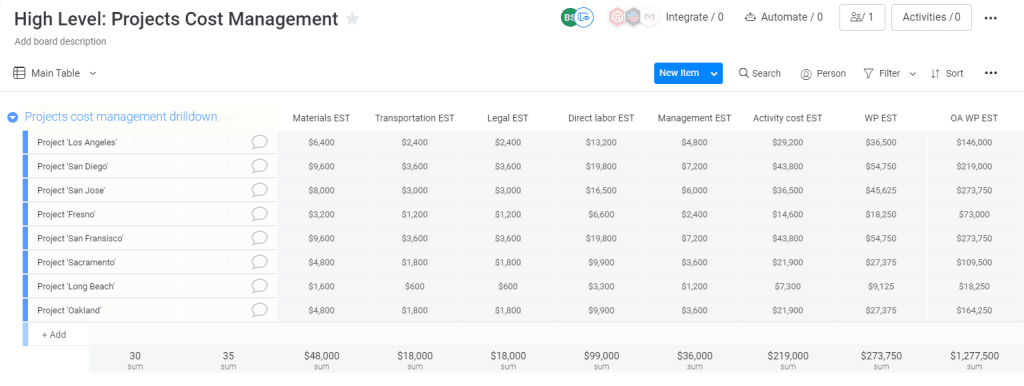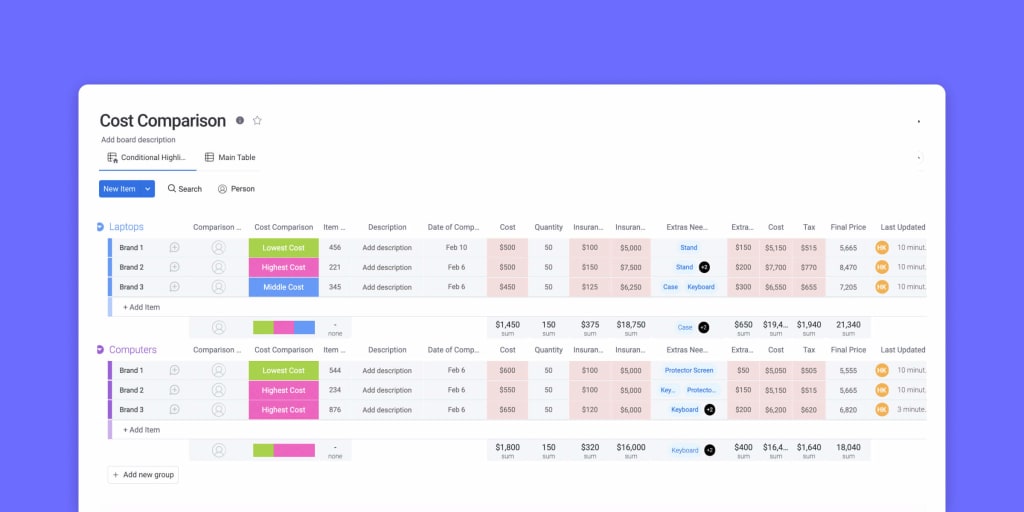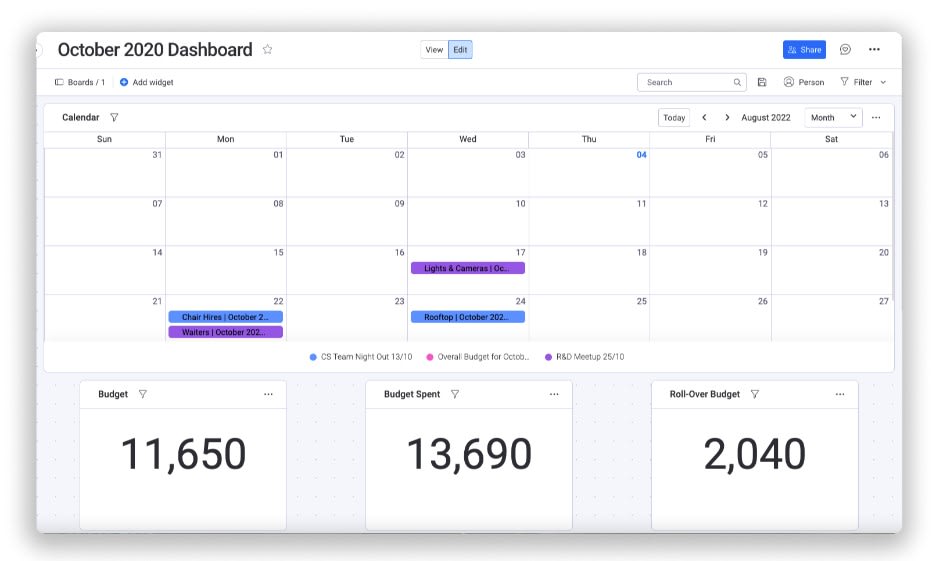Nail your cost breakdown structure for efficient project management
Blog: Monday Project Management Blog
A good cost breakdown structure is a fundamental element of project management.
It helps you regain cost control and makes sure the numbers stack up at every stage of the project management lifecycle.
Though most people know the importance of cost control, many struggle to manage it.
In this guide, you’ll learn the basics of cost breakdown structures, with tips to easily manage yours today.
What is a cost breakdown structure?
A cost breakdown structure (or CBS) documents all the costs incurred for a project. It provides granular information on costs involved at every stage of project management.
Whether you’re planning a new project or working with a budget based on estimated costs, a cost breakdown structure lets you see how the numbers stack up.
Put simply, a cost breakdown structure helps you regain cost control and organize project budgets.
How to nail your cost breakdown structure in 5 easy steps
Making your own cost breakdown structure doesn’t have to be complicated. Here are five key steps to create your own cost breakdown structure.
Step 1: Analyze your project lifecycle
Before you can identify costs, you need to determine what each stage of your project entails. The project life cycle has five key stages:
- Phase one: Initiation. The initiation phase is where you identify a business need or problem and a potential solution.
- Phase two: Planning. The planning phase is where the work that you described in initiation is broken down into manageable chunks.
- Phase three: Execution. The execution phase is where you get stuck in with managing project resources, timelines, budgets, and stakeholders.
- Phase four: Controlling. The controlling phase is where you laser in on each part of the project to see if anything is falling off track.
- Phase five: Closeout. As the name depicts, the closeout phase is where you review the project success.
Then, once you have determined each stage of the lifecycle you can start to map out your project costs.
Step 2: Estimate your project costs
The next step is to estimate the work cost for each task or activity you have identified for each stage of your project lifecycle. For example, typical costs during the initiation stage might include your choice of project management Work OS platform.
It’s worth noting that estimating time for different tasks can be challenging, especially if you’re not directly involved in the implementation of those specific tasks. Luckily, there are a few different cost estimation techniques to help you estimate costs, including parametric estimation, one of the formula-driven estimation tools based on data from previous projects.
Once you’ve estimated the costs of work for all stages of the project management lifecycle, you can use them to work out the final costs for your project.

Step 3: Build in contingency
No matter how accurate your estimates are, it’s always worth adding in some contingency.
For example, one of your team members may get sick, making them unable to complete a task on time. Building in some contingency will improve the accuracy of your cost structure when changes occur.
Ensure your cost breakdown structure also includes an allocation to overhead costs.
Overhead costs include various costs that aren’t related to specific tasks, but are necessary for the company to function and the project to take place. Administrative costs, for example, are an overhead cost that should be considered.
Step 4: Sense-check
It’s good practice to check your estimates against your available budget. So, once you’ve created your cost breakdown structure, you need to check whether your total estimated cost matches up with your initial estimates.
If your cost breakdown structure comes out higher, you can always look at ways to manage costs.
Step 5: Add costs to your project management platform
The last step in creating a cost breakdown structure is to assign costs to your project management platform. For example, on monday.com you can add costs to each individual element of your project, set up formulas, automations for when you go over budget, and much more.
Instead of relying on messy spreadsheets, adding costs into your project management platform provides visibility and transparency to key stakeholders and much better insight into costs for each project stage.

In the next section, we’ll walk you through this in more detail.
Manage your cost breakdown structure on monday.com
Once you have a solid approach to managing your cost breakdown structure, you have better control of project costs to avoid going over budget. Although the process can seem daunting, you can use monday.com’s Work OS to help in the process.
Through allocating costs to individual tasks on a project board you’ll be able to access the data you need for your cost breakdown structure in a fraction of the time. The great thing about this is that you can add up the costs in chunks so you could create an overall cost for a project or for a particular level of task.
You can use a Numbers Column for budget targets, and a Numbers Column to see what you’ve spent.
Plus, you don’t have to do the math every time you want to know where you stand. You can add an “If” formula, which takes the delta of the two numbers and sends the message “Within Budget” when you’re below or have met the intended budget, or “Over Budget” when you’ve exceeded budget.
Additionally, to reduce the amount of manual work you and your team needs to do, you can add in automations such as due dates and reminders, recurring tasks and events, and more!
Finally, dashboards are a great place to keep all of your costs in one place. You can even connect several boards to one dashboard to compare and contrast stats, numbers, and progress.

Frequently Asked Questions
How to make a cost breakdown structure?
You can make a cost breakdown structure by estimating how much you think each task in the project management lifecycle will cost to complete. Essentially, if you add on the values for each of those project tasks you’ll be able to work out at any level exactly how much the project will cost overall.
What is the purpose of a cost breakdown structure?
Budgets are an integral part of a project. The overall purpose of a cost breakdown structure is to help you manage project management costs effectively. You can have better control over your budgets and other costs, and a clearer view of any overspending.
What is the use of a cost breakdown structure?
Cost breakdown structures are a crucial part of project planning and management, as it allows you to gain better insight into how much you spend and what you spend your project budget on.
Likewise, a solid cost breakdown structure provides an easier understanding of how a project is tracking against the plan.
Simplify cost breakdown structures
Spreadsheets are popular for cost breakdown structures, yet there are some limitations, which may not make them the best choice for everyone. Typically, spreadsheets are not that easy to share, they are not user-friendly, and visualizing costs is difficult.
In contrast, using a platform like monday.com to split costs across your project plan provides a much clearer view and management of costs.
You can see a committed view of spend across specific items on a project board and see how costs stack up overall by combining several boards into one dashboard. Our project cost management template is a great place to start.
The post Nail your cost breakdown structure for efficient project management appeared first on monday.com Blog.
Leave a Comment
You must be logged in to post a comment.







